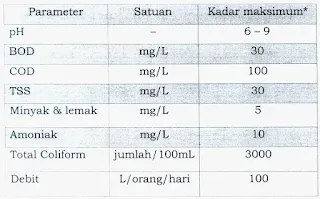What is Ammonia in Wastewater?
Ammonia is a chemical compound commonly found in domestic wastewater, from household or communal sources. The source of this wastewater can come from various places such as kitchen sinks, toilets, urinals, showers, and other related daily activities at home. Chemically, ammonia is known by the formula NH3 and consists of one nitrogen atom and three hydrogen atoms.

|
| Picture Source : Ion Science of Ammonia |
Ammonia in domestic wastewater is produced from the remnants of proteins and nutrients generated by human bodies. After food and beverages are digested by enzymes, ammonia is formed as a metabolic product. Domestic wastewater contains ammonia as one of its main components due to this process. The concentration of ammonia in domestic wastewater varies normally but can reach up to 50 mg/L or more.
In some amounts, ammonia in wastewater is essential for bacteria as a nutrient source to support their growth in wastewater treatment. However, excess ammonia in wastewater can negatively impact the environment, particularly aquatic ecosystems.
Ammonia in domestic wastewater has significant negative effects on the environment, especially water ecosystems. Most ammonia reacts with water molecules to produce ammonium ions (NH4+). However, the percentage of ammonia that does not react and remains in gaseous form (NH3) increases when pH rises and temperatures are high.

Characteristics of Ammonia in Wastewater:
- Ammonia (NH3) is a chemical compound in gaseous state and smell.
- Corrosive and causes rust that can reduce the strength of iron pipes in sewage systems and equipment made of iron.
- molecular weight is 17.0306 g/mol. The atomic weights of Nitrogen (N) are 14.01 g/mol and those of Hydrogen (H) are 1.01 g/mol.
- Soluble in Water. In normal conditions, 1 liter of water can dissolve 1180 liters of ammonia.
- Liquefied ammonia behaves easily in liquid state.
The Negative Impact of Ammonia on Wastewater
High concentrations of ammonia in domestic wastewater can cause irritation to the skin, eyes, and nervous system, as well as respiratory problems in humans, which can lead to death. Ammonia is also corrosive and can cause rust, which can reduce the strength of iron pipes in wastewater piping systems and equipment made of iron without anti-corrosive coating. Therefore, ammonia must be removed from domestic wastewater before being discharged into the environment according to the legal provisions of the maximum limit.
The maximum Ammonia content in domestic wastewater discharge set by the government through Minister of Environment and Forestry Regulation Number 68 of 2016 is 10 mg/l at a maximum flow rate of 100 Liters/person/day
Methods to Reduce Ammonia Levels in Wastewater Treatment Plants (WWTPs)
Methods to reduce or eliminate Ammonia in wastewater can be done using several methods, including:
- It can be done through chemical processes using the redox process. However, we need to consider the potential increase in COD and the degree of certain chemical concentrations in wastewater discharge.
- Or by using biological oxidation processes, which are safer for wastewater discharge quality.
To support the positive progress of our clients, our team are certified and have solid experience in the field of WWTP to provide excellent services that ensure each customer receives sustainable and cost-effective solutions that are tailored specifically to the customer's specific needs
Our company products/services include:
- WWTP design with technology specifically tailored to the customer's needs.
- Excellent equipment / machinery products to ensure that any equipment / machinery we supply can operate optimally according to its function.
- WWTP assessment / evaluation and technical documentation to ensure that the designed WWTP meets the applicable effluent quality criteria and standards, providing benefits such as completeness of permitting documentation.
- Upgrade / Optimizations/ Retrofitting to increase the treatment capacity of the WWTP and the quality of the treated products.
- Repair / Maintenance to maintain the condition of the WWTP so that production remains optimal in accordance with the quality of the effluent and to extend the life of the WWTP equipment.
The website www.mediasarangtawon.com was built since October 09, 2014, which has been connected with hundreds of customers and nationwide project references with various types of technology and various technical conditions.
Be sure to only connect with us and do not hesitate to ask us questions to get comprehensive services. If you have any additional questions or would like to provide feedback, or if you would like to use our services for the above services, please feel free to contact us via email [mediasarangtawon.com@gmail.com]. We are happy to respond to any questions or comments you may have.
- The commercialization of MST is only contained in writing in B2B sales documents sent via email and the accountability of MST is contained in writing in an agreement / contract document mutually agreed upon by each interested party directly and is private and confidential as part of the ethical standards of a company..
- To make things easier for you, information requests can be sent via the contact page. Contact Us


